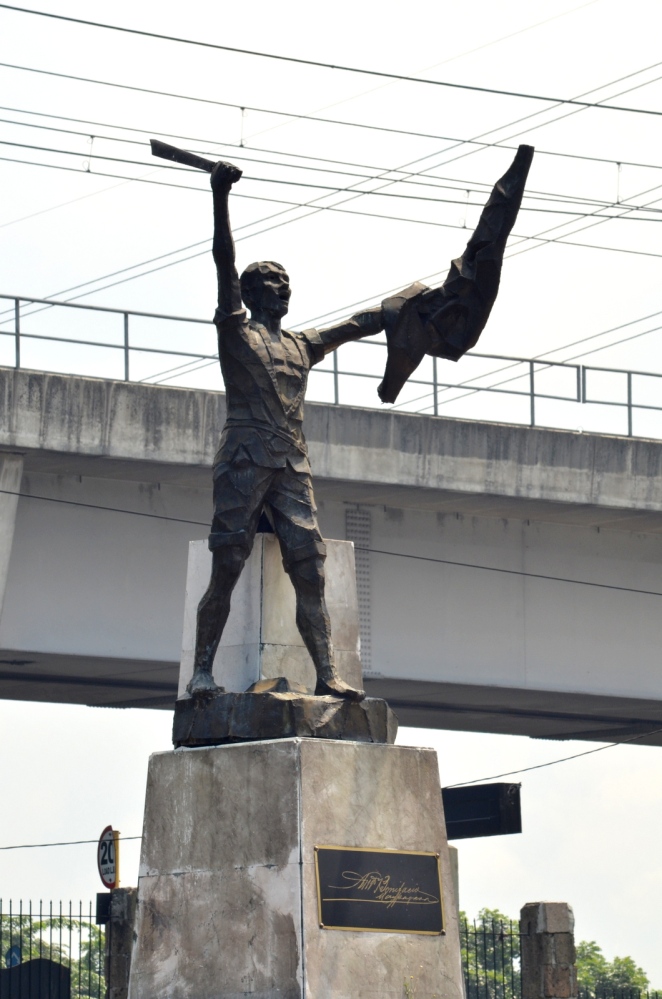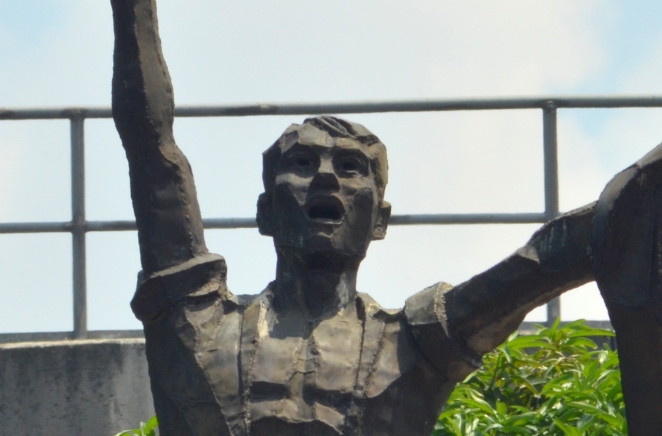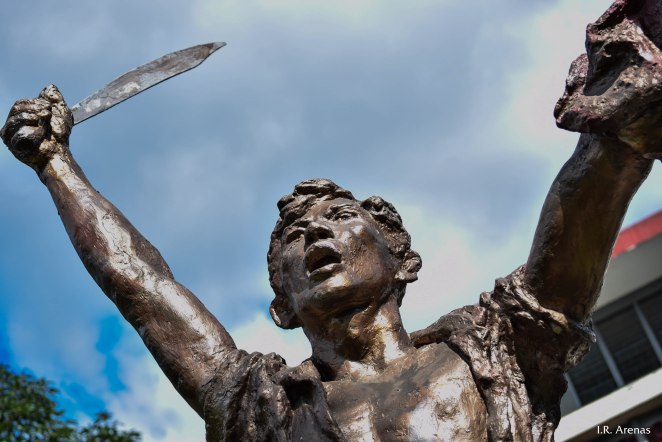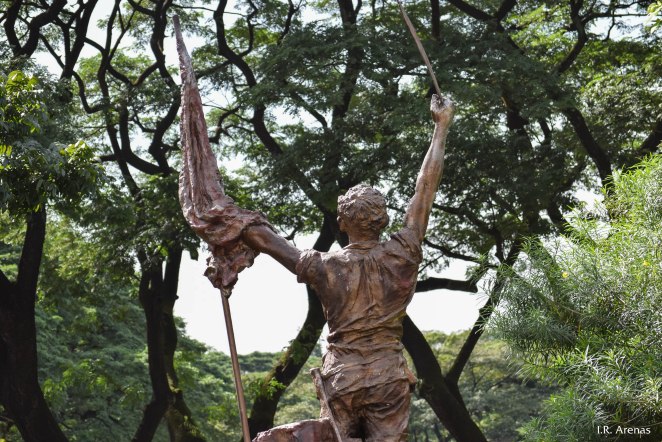Sculpture 08: Alaala ng Bayang Filipino sa mga Bayani ng (18)96
and Bonifacio Monument in Balintawák
(UPDATED IMAGES) This monument generated art and historical misconceptions is the “Homenaje del pueblo filipino a los héroes del 96” (Alaala ng Bayang Filipino sa mga Bayani ng 96). This was crafted by Ramon Martinez out of concrete, installed on 27 August 1911, and was unveiled on 3 September 1911 at Balintawák (then part of Kalookan, now a part of Quezon City). This even predated the Rizal Monument (Motto stella) by two years.

This statue was polychromed at different times. Once it was painted grayish blue (shirt) and red (trousers).
The statue is a homage to the katipunero revolutionaries of the Philippine Revolution that started in 1896. It is known for its many names:
- Monumento sa mga Bayani ng 1986
- Bantayog ng Sigaw ng Pugad Lawin
- El Grito de Balintawák (grito means “shout, scream or cry”)
The question of the location of the “cry” where Bonifacio called the members of the Katipunan to arms is left to the historians—Balintawák, Pugad Lawin, Gulod, among others.
Historian Ambeth Ocampo suggested in a lecture in 1997 that the event be called “Cry of Kalookan” for “it was not one but a series of events which saw the Katipuneros moving from one place to another towards the end of August 1896 in Balintawak or better still, [Kalookan]”. Honoring Kalookan instead would put to rest the dispute of precedence among the locations in contention. There were many “cries”, as Ocampo suggested. (This makes more sense, actually.)
The statue is a figure of a bare-chested young man wearing a barò and folded trousers. He is in an apparent outcry, holding a gúlok on his right hand and a battle standard on his left. A holster is tied to his waist. He is barefoot.
Many mistakenly took this icon for Andres Bonifacio, the leader of the Katipunan. But it was not him.
Ocampo mentioned in a book that the figure was based on the 14 July 1911 cover of the newsmagazine Renacimiento Filipino that was sketched by Jorge Pineda.
On 29 November 1968, the statue was transferred to Vinzons Hall, the student center of the University of the Philippines Diliman, because of the the construction of the Manila North Diversion Road (North Luzon Expressway today).
Below are the texts of the plaques that commemorate the statue, placed on two different occasions:
NATIONAL HISTORICAL COMMISSION, 2011
Monumento sa mga Bayani ng 1986
Itinayo sa Balintawak, noo’y sakop ng Kalookan, 27 Agosto 1911, bilang pag-alaala sa mga bayani ng Himagsikang Filipino ng 1986. Nilikha ni Ramon Martinez y Lazaro. Pinasinayaan, 3 Setyembre 1911. Inilipat sa Bulwagang Vinzons, Unibersidad ng Pilipinas, Diliman, Lungsod Quezon, 29 Nobyembre 1968.
NATIONAL HISTORICAL COMMISSION, 1968
Ang bagong kinalalagyan ng Bantayog ng Sigaw ng Pugad Lawin sa Diliman, Lungsod ng Quezon, ay pinasinayaan noong 29 ng Nobyembre 1968.
Sa ngalan ng Lupon sa Bantayog ng Sigaw ng Pugad Lawin at ng Sangguniang Pangmag-aaral sa U.P. ay tinanggap ng Unibersidad ng Pilipinas sa Pambansang Kapulungang Pangkasaysayan ang nasabing bantayog. Sa pagsisikap ng Kapatirang Upsilon Sigma Phi ay lumikha ang mga lider mag-aaral sa U.P. ng isang Lupon sa Bantayog ng Sigaw ng Pugad Lawin na siyang nangasiwa sa paglilipat ng bantayog sa Diliman, Lungsod ng Quezon mula sa dating kinalalagyan sa Balintawak.
Here is an image of the statue when it was still looming in Balintawák.
A close copy (not really a replica) of this icon now stands at the cloverleaf in Balintawák. However, the statue is clearly identified as Bonifacio himself, as attested by the plaque bearing his signature and nom de guerre Maypagasa.

Take note of the plaque bearing the signature and nom de guerre of Andres Bonifacio.
This metal sculpture was made by National Artist Napoleon Abueva. I am not sure when was this installed in the area.

The countenance of this version certainly resembles the Bonifacio in our minds.
The original is more organic, while the new one is angular.Comparing again the statues in their present environments:
Statues likened to this figure are scattered around the country. Still, the misbelief that it is indeed Bonifacio is rife.
References:
Chua, Michael Charleston. “National Children’s Book Day 2013 Keynote Address on Bonifacio and Reading.” Xiao Time. Published on 17 July 2013.
Filipinas Hertiage Library. “The Bonifacio Monument: Hail to the Chief!” Library Link. Published on 12 November 2003.
Ocampo, Ambeth. Bones of Contention: The Andres Bonifacio Lectures. Mandaluyong: Anvil, 2014.
All images are mine.






すごい!Hindi na puro photos na lang ang post mo. Magiging academic blog na ba ito? hehe
がんばって ね、しんじん!